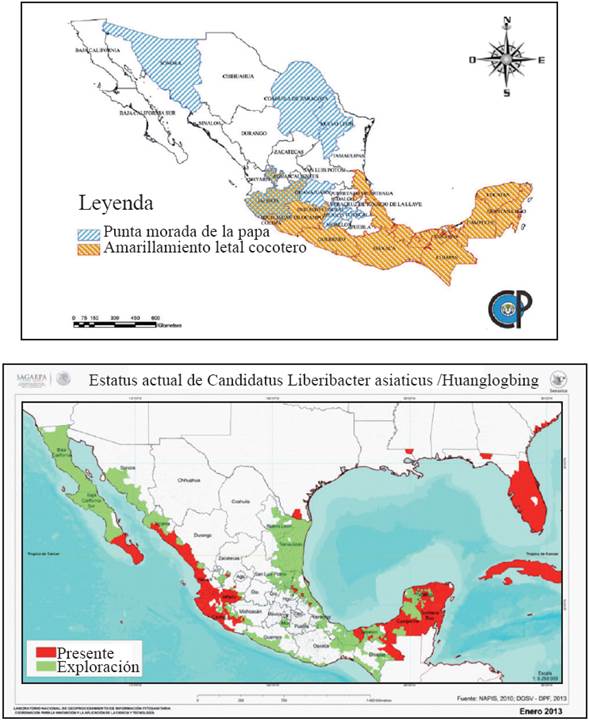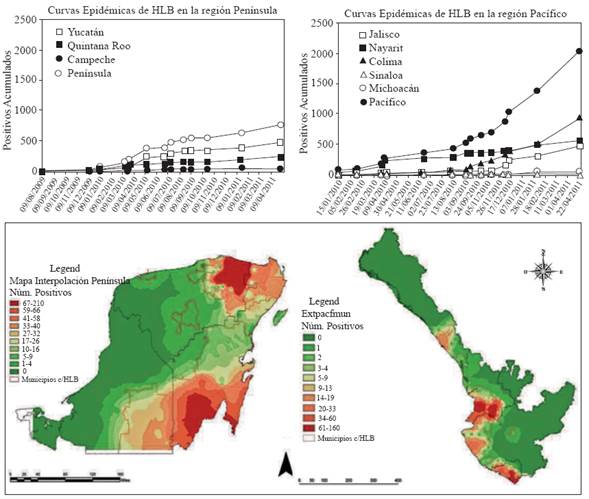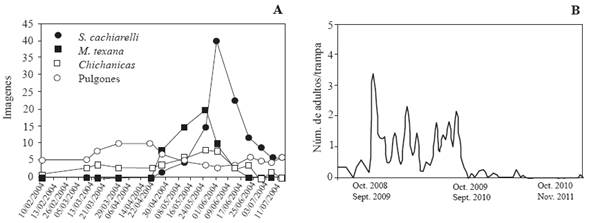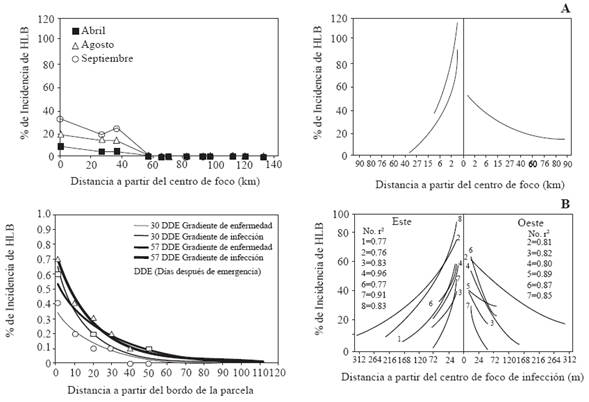Services on Demand
Journal
Article
Indicators
-
 Cited by SciELO
Cited by SciELO -
 Access statistics
Access statistics
Related links
-
 Similars in
SciELO
Similars in
SciELO
Share
Revista mexicana de fitopatología
On-line version ISSN 2007-8080Print version ISSN 0185-3309
Rev. mex. fitopatol vol.32 n.2 Texcoco 2014
Review articles
Epidemiological Surveillance and Current Status of Coconut Lethal Yellowing, Potato Purple Top and Citrus Huanglongbing (HLB) in Mexico
1 Colegio de Postgraduados, Campus Montecillo-Fitopatología, Texcoco, Edo. de México.
2 Centro de Investigación Científica de Yucatán A.C. Mérida, Yucatán.
3 Universidad Autónoma Agraria Antonio Narro Buenavista, Saltillo, Coahuila, México.
4 Centro Nacional de Referencia Epidemiológica Fitosanitaria (CNRF)- DGSV. México, D.F.
5 Dirección de Protección Fitosanitaria-DGSV. México, D. F.
The agricultural productivity of a country is currently considered a strategic asset for economies and food security. In this context, plant health is gradually getting increased recognition as a national priority and leading to the establishment of surveillance systems for enhancing prevention and phytosanitary management strategies. In recent years, pathogenic agents of systemic-vascular action on their hosts and associated vector insects have caused high-intensity epidemics at regional level. This has involved the movement of microbiological agents at continental level with devastating effects in some cases. Some of the most important among this type of pathogenic agents are the prokaryote microorganisms, i.e. organisms that lack a membrane-bound nucleus with cytoplasmic DNA. This can be explained by their generic condition to exhibit an obligate parasitism; a unicellular thallus adapted to phoretical conditions via vector; a systemic condition mainly associated with the phloem, which causes chronic infections with gradual productive damage to perennial hosts or to hosts with seasonal succession by vegetative spreading; and, availability of permanent inoculum in the grown host and/or in combination with secondary hosts.
In Mexico, among the epidemics caused by prokaryote organisms include coconut lethal yellowing (ALC) induced by coconut lethal yellowing phytoplasma (Species group 16SrIV- Coconut Lethal Yellows Group); citrus huanglonbing (HLB) caused by the species Candidatus Liberibacter africanus (CLaf), Candidatus Liberibacter americanus (CLam) and Candidatus Liberibacter asiaticus (CLas) -the latter being reported in Mexico- and potato purple top (PMP). In the case of PMP two organisms have been found to be associated: potato purple top phytoplasma (Species group 16SrII Peanut WB Group) (NCBI, 2013) and Candidatus Liberibacter solanacearum (CLs), a bacterium associated with the disease known as zebra chip.
ALC was detected in Mexico in the late 70s causing a devastating mortality of around 700 thousand coconut plants (Cocos nucifera) in the Mexican Caribe (Góngora-Canul et al, 2004; Pérez-Hernández et al, 2004) and 7.9 million plants across the Caribbean region (Mora and Hernández, 2005. Unpublished data; Oropeza et al., 2005). This led to the replacement of coconut trees using tolerant materials such as the ALC-tolerant Malayan dwarf that used to be grown in gardens. As a result, in all new coconut plantations Malayan dwarf varieties were grown (Góngora-Canul et al., 2004). ALC typical symptoms are development of inflorescences necrosis, small fruit drop and frond yellowing starting by the lower parts, total defoliation and dead leaves. The causal agent is systemically distributed up to the root system (Mora-Aguilera and Escamilla, 2001).
Introduced in Mexico in 2009, HLB has significant socioeconomic and production impacts on the Mexican citriculture, particularly on citrus fruits with losses from 17.3 % to 60 % (Robles-González et al, 2013; Flores-Sánchez et al., 2012; Esquivel-Chávez et al., 2012;). Leaf HLB symptoms include stains, asymmetric angular spots, nervation thickening, chlorosis and defoliation; asymmetrical growth of fruit, albedo thickening and necrotic seed (Esquivel-Chávez et al, 2012). Also, there are records of PMP, which is considered the second most important potato disease (Solanum sp.) following late blight (Hernández-García et al., 2010; Almeyda et al., 2008; Rubi-Covarrubias et al., 2006), and symptoms of the PMP type since the late 40s, with an increase in the last 10 years and losses up to 40 % derived from early phytoplasma infections (Hernández-García et al., 2010). Symptoms include plant dwarfing, knots thickening and shortening, aerial tubers, and eventually, purple pigmentation on leaves (Cadena et al., 2003; Salas et al, 2013). Zebra chip symptoms are similar to PMP symptoms besides tuber stripping (Munyaneza, 2012).
Currently, ALC, PMP and HLB are distributed in most of the Mexican states where their main hosts are grown (Figure 1). ALC distribution is mainly associated with ecotypes of C. nucifera known as Altos del Atlántico that recorded the highest epidemiological intensity in the 80s. The devastation occurred in the Yucatan Peninsula apparently influenced the drastic reduction of the inoculum by limiting the epidemic progress in the Gulf of Mexico and the rest of the country. There are no records of epidemics of the ecotype Altos del Pacífico but the speed and expression of the symptoms has changed, as well as the occurrence of these pathogen genetic variations based on rDNA studies (Oropeza et al., 2005). This is a potential risk that must be monitored due to the importance of the Pacific watershed as a coconut growing area (Góngora-Canul et al, 2004). So far, HLB has two epidemic scenarios: the Yucatan Peninsula with low epidemic intensity and marked influence of urban and rural backyards, and the Pacific watershed with high-intensity epidemics mainly affecting Mexican and Persian lime crops (Robles-González et al., 2013; Flores-Sánchez et al., 2012) (Figure 2). PMP is distributed across central and northern Mexico with apparently greater occurrence in the northeast area (Rubio-Covarrubias et al., 2006) (Figure 1).

Figure 1 A) Distribution of PMP and ALC in Mexico. Source: Prepared by author, and B) Distribution of HLB in Mexico (SENASICA, Enero, 2013. GIIIC, 2012).

Figure 2 Epidemic scenarios of HLB in the Yucatán Peninsula and the Pacific reported up to 6 May 2011. Scenarios are currently the same with the addition of other states across both regions (See Figure 1). A) Temporal progress at regional level in three states and at peninsular level. B) Interpolated spatial progress at regional level.
These phytosanitary problems have in common their association with vector insects of the order Hemiptera and Homoptera. From these, Psillidae and Cidadellidae families have been concurrently associated with these diseases (Table 1).
Table 1 Characteristics of putative vectors associated with ALC, HLB and PM causal agents.

N/I= No information.
1 These vectors have shown their positive condition through PCR but no transmission studies have been conducted.
2 This vector has been verified using phytoplasma transmission tests and only its positive property has been verified in CLs using molecular techniques.
Apparently, vectors associated with ALC, HLB and PMP have adaptive and large agroclimatic capacity and migratory behavior at intermediate and large distances, which explains their regional (López-Arroyo and Cortez, 2013; Almeyda et al., 2008; Rubio-Covarrubias et al., 2006; Góngora-Canul et al., 2004; Pérez-Hernández et al., 2004) and continental distribution (Salcedo et al., 2010). Vegetative transmission has also been found in HLB and PMP, which is particularly important in HLB at nursery level and in PMP in tuber transmission with estimated 40 % for phytoplasma and 60 % for CLs in Nuevo León (Hernández-García et al., 2010).
Colonization habits of these vectors (Figure 3) define a population dynamics that depends on vegetative flows, particularly for vectors associated with PMP and HLB (López-Arroyo and Cortez, 2013; Almeyda et al, 2008). In ALC the dynamics depend more on precipitation and temperature factors and alternate hosts for the development of the immature stages of the insect, especially gramineae.

Figure 3 A) Incidence of vector populations of potato purple top in Cristal, Nuevo León, in 2003-04; B) Number of adults of D. citri per trap in three cycles of sweet orange production in Nuevo León. Source: Almeyda et al., 2008 y López-Arrollo and Cortez, 2013, respectively.
The migratory behavior and high populations of vectors during the inductive phenological stages explain the explosive epidemic rates with 80, 100 and 75 % final incidences (yf) for ALC, HLB and PMP, respectively (Table 2). Similarly, they show high dissemination rates. For example, at regional level, in the Yucatán Peninsula the maximum dissemination distance for ALC was 90 km/year (r2=0.72) (Góngora-Canul et al., 2004), while the maximum dissemination distance for HLB was 80 km/year (r2=0.98) (Flores-Sánchez et al, 2011) (Table 2 and Figure 4A). At plot level, ALC dissemination rates showed aggregate patterns with border and focus trends distributed across the plots with gradients between 48-312 m (Góngora-Canul et al., 2004; Pérez-Hernández et al., 2004) (Figure 4B). For HLB and PMP a strong border effect is well documented with distances between 15-35 m, respectively (Robles-González et al., 2013, Hernández-García et al., 2010). For PMP, the border effect was found in phytoplasma and CLs.
Table 2 Comparative, temporal and spatial epidemic parameters associated with ALC, HLB and PMP.

1 N/I= No information.
2 Epidemic progress of PMP at plot level; epidemic progress of ALC and HLB at regional level.

Figure 4 A) Spreading gradient at regional level for HLB and ALC; and B) Spreading gradient at plot level for PMP and ALC. Source: Flores-Sánchez et al., 2011; Hernández-García et al., 2010; and Góngora-Canul et al., 2004.
Since 2010 the Epidemiological Surveillance Program (SINAVEF-CNRF, 2013) has increased the number of prokaryotes plagues monitored at national level with a total of 13 plagues, which suggests the current relevance of the phytosanitary problems caused by these pathogens. Specifically for ALC y HLB, due to their epidemic effects at regional level, it has been crucial for Mexico to develop official strategies to prevent and mitigate risks. Regarding ALC, actions were taken in the 90s that are included in NOM-003-FITO-1995, NOM-015-FITO-1995 and NOM-067-FITO-1999. Particular emphasis was placed on establishing a program to eradicate visually diseased plants. However, the growing epidemic rates required a change of strategy based on the integration of gradients both at plot and regional levels, and PCR detection in a sampling and eradication program based on epidemiological criteria (Mora-Aguilera and Escamilla-Bencomo, 2002). Currently, the program is focused on the general health of the crop, and regarding surveillance, special emphasis is placed on red acari (Raoiella indica) and red palm weevil (Rhynchophorus ferrugineus), but there is no monitoring of the status of ALC at national level.
For HLB, the "Acuerdo por el que se dan a conocer las medidas fitosanitarias que deberán aplicarse para el control del Huanglongbing ( Candidatus Liberibacter spp.) y su vector" (Agreement establishing phytosanitary measures to control Huanglongbing ( Candidatus Liberibacter spp.) and its vector (DOF, 2010) was implemented. This agreement includes certification strategies for propagative plant material, sampling, diseased plants eradication; vector control and focus and positive insects' surveillance. At pilot level, in 2012, strategies coordinated by the Mexican official authorities were implemented in various states including a regional control of the vector using insecticides. The current trend is the establishment of control areas of D. citri at regional level (ARCOS) supported by an innovative regional monitoring program through a GPRS geopositioning system in 21 states.
There are no specific guidelines for PMP. However, there are national regulations in place that rule tubers production and movement in view of other phytosanitary problems (NOM-O25-FITO-2000 and NOM-O40-FITO-2001). Although these guidelines may not apply to PMP because of its current distribution at national level, they suggest the possibility of including this kind of organisms in a generic regulatory framework as part of a proper decision-making scheme, considering that tubers are an efficient mean of spreading (Hernández-García et al, 2010).
CONCLUSIONS
The design and strengthening of a surveillance system is a viable strategy for ALC, HLB and PMP. HLB, aligned with its importance for the citrus productivity chain, has currently a surveillance system for regional management through the control of the vector D. citri. Although for ALC and PMP diagnosis and epidemiological tools have been developed in order to implement a successful surveillance system, those tools have not been used or have been left aside. However, the potential production losses and social impacts, as well as the national phytosanitary structure formed by the network of Plant Health State Committees could contribute to this purpose. For ALC, HLB and PMP an efficient surveillance model must consider monitoring variant forms of the disease and/or species, as well as their regional prevalence based on the following strategies:
) Develop an efficient method to detect the major pathogenic agent mainly based on molecular methods due to its sensitivity to detect the agent in plants and vectors.
) Emphasis in monitoring systems for vector(s) at regional level including phenological consideration for their optimization.
) Incorporate detection of the pathogenic agent in the vector to develop action plans with preventive purposes or early alerts for detection.
) Develop management strategies through generation, validation and/or transference of technologies locally developed or based on experiences in other countries.
LITERATURA CITADA
Almeyda-León, I. H., Sánchez-Salas, J. A. y Garzón-Tiznado, J. A. 2008. Vectores causantes de la Punta Morada de la Papa en Coahuila y Nuevo León. Agricultura Técnica en México. 34(2): 141-150. [ Links ]
Cadena-Hinojosa, M. A., Guzmán-Plazola, R., Díaz-Valasis, M., Zavala-Quintana, T. E., Magaña-Torres, O. S., Almeyda-León, I. H., López-Delgado, H., Rivera-Peña, A. y Rubio-Covarrubias, O. 2003. Distribución, Incidencia y Severidad del Pardeamiento y la Brotación Anormal en los Tubérculos de Papa (Solanum tuberosum) en Valles Altos y Sierras de los Estados de México. Revista Mexicana de Fitopatología. 21: 248-259. [ Links ]
DOF. 2010. Acuerdo por el que se dan a conocer las medidas fitosanitarias que deberían aplicarse para el control del Huanglongbing (Candidatus Liberibacter spp) y su vector. http://www.dof.gob.mx/nota_detalle.php?codigo=5155459&fecha=16/08/2010. [ Links ]
Esquivel-Chavez, F., Valdovinos-Ponce, G., Mora-Aguilera, G., Gómez-Jaime, R., Velázquez-Monreal, J., Manzanilla-Ramirez, M. A., Flores-Sánchez, J. L. y López-Arroyo, J. I. 2012. Análisis Histológico Foliar de Cítricos Agrios y Naranja Dulce con Síntomas Ocasionados por Candidatus Liberibacter asiaticus. Agrociencia. 46:769-782. [ Links ]
Flores-Sánchez, J. L., Mora-Aguilera, G., Loeza-Kuk, E., Domínguez-Monge, S., Acevedo-Sánchez, G., Rivas- Valencia, P., Ruiz-García, N., López-Arrollo, J. I., Hernández-Chan, E., Novelo-Cocon, A., López-Sánchez, P., y Sánchez-Rebolledo, F. 2011. Gradientes de Dispersión del HLB a partir de Focos Iniciales de Infección en la Península de Yucatán. Memoria del 2do. Simposio Nacional sobre Investigación para el Manejo del Psílido Asiático de los Cítricos y el Huanglongbing en México. 5 y 6 de Diciembre. Colegio de Postgraduados. Montecillo, Texcoco, Edo. de México. pp: 83-87. [ Links ]
Flores-Sánchez, J. L., Mora-Aguilera, G., Loeza-Kuk, E., Domínguez-Monge, S., Acevedo-Sánchez, G. y López-Arroyo, J. I. 2012. Yield Loss Modeling of Candidatus Liberibacter asiaticus on Persian Lime (Citrus Latifolia) in southern Mexico. : Book of Abstracts of the XII International Citrus Congress. S12P01 199p. Valencia, Spain. 18-23 November. [ Links ]
Góngora-Canúl, C. C., Pérez-Hernández, O., Pech-Cauich, O., Escamilla-Bencomo, J. A. y Mora-Aguilera, G. 2004. Gradientes de Diseminación del Amarillamiento Letal en Cocotero (Cocos nucífera) en Yucatán, México. Revista Mexicana de Fitopatología. 22:370-376. [ Links ]
Hernández-García, V., Almeyda-León, I. H. , y Frías-Treviño, A. G. 2010. Estrategias de Manejo Fitosanitario de la Punta Morada de la Papa/Zebra Chip: Caso Nuevo León y Coahuila. XIII Congreso Nacional de papa. 9-11 septiembre. Tapalpa, Jalisco. México. [ Links ]
López-Arroyo, J. I. y Cortez-Mondaca, E. 2013. Uso Racional de Insecticidas en las ARCOS. En: Memorias de la Reunión Nacional de Sanidad Vegetal. México, D.F. 16-19 Abril. [ Links ]
Munyaneza, J. E. 2012. Zebra Chip Disease of Potato: Biology, Epidemiology, and Management. Am. J. Pot. Res. 89: 239-350. [ Links ]
Mora-Aguilera, G. y Escamilla, G. (Coord). 2001. Simposium Amarillamiento Letal del Cocotero. XXVIII Congreso Nacional de Fitopatología. Querétaro, México. 15-18 Julio. Compilación electrónica en CD. [ Links ]
Mora-Aguilera, G. y Escamilla-Bencomo, J. A. 2002. Dispersal Potential of Lethal Yellowing of the Coconut Palm a Quarantine Disease in Mexico. pp. 128-133. In: Proceedings of the Expert Consultation on Sustainable Coconut Production through Control of Lethal Yellowing Disease. [ Links ]
National Center of Biotechnology Information (NCBI). Consultado el 30 de Junio de 2013. http://www.ncbi.nlm.nih.gov/Taxonomy/Browser/wwwtax.cgi?mode=Undef&id=33926&lvl=3&keep=1&srchmode=1&unlock . [ Links ]
NOM-003-FITO-1995. SENASICA-DGSV. http://www.senasica.gob.mx/?doc=628. [ Links ]
NOM-015-FITO-1995. SENASICA-DGSV. http://www.senasica.gob.mx/?doc=612. [ Links ]
NOM-067-FITO-1999. SENASICA-DGSV. http://www.senasica.gob.mx/?doc=697. [ Links ]
Oropeza, C., Escamilla, J. A., Mora-Aguilera, G., Zizumbo, D. and Harrison, N.A. 2005. Coconut lethal yellowing. 349-363 pp. In: Coconut Genetic Resources. Batugal, P., Ramanatha, V. and Oliver, J. Eds. Ed. IPGRI-APO. Malaysia. [ Links ]
Pérez-Hernández, O., Góngora-Canúl, C. C., Medina-Lara, M. F., Oropeza-Salin, C., Escamilla-Bencomo, J. A. y Mora-Aguilera, G. 2004.Patrón Espacio-Temporal del Amarillamiento Letal en Cocotero (Cocos nucifera) en Yucatán, México. Revista Mexicana de Fitopatología . 22:231-238. [ Links ]
Robles G, M. M., Velázquez M., J. J., Manzanilla R. , M. A., Orozco S., M., Medina U., V. M., López-Arroyo, J. I. y Flores-Virgen, R. 2013. Síntomas del Huanglongbing (HLB) en Limón Mexicano (Citrus aurantifolia) y su Dispersión en el Estado de Colima, México. Revista Chapingo Serie Horticultura. 19(1): 15-31. [ Links ]
Rubio-Covarrubias, O. A., Almeyda-León, I. H., Ireta-Moreno, J., Sánchez-Salas, J. A., Fernández-Sosa, R., Borbón-Soto, J. T., Díaz-Hernández, C., Garzón-Tiznado, J. A., Rocha-Rodríguez, R. y Cadena-Hinojosa, M. A. 2006. Distribución de la Punta Mora y Bactericera cockerelli Sulc. en las principales zonas productoras de papa en México. Agricultura Técnica en México . 32(2):201-211. [ Links ]
Salas-Marina, M. A., Sánchez-Arizpe, A., García-Martínez, O., Almeyda, León, I. H., Garzón-Tiznado, J. A. y Flores-Olivas, A. 2013. Eficiencia de insectos vectores en la transmisión de fitoplasmas en Papa (Solanum tuberosum) 00:000-000. No publicado. [ Links ]
SINAVEF-CNRF. 2013. Lineamientos del Programa Nacional de Vigilancia Epidemiológica Fitosanitaria. http://portal.sinavef.gob.mx/EpidemiologiaFitosanitariaInicio.html. [ Links ]
Received: December 01, 2014; Accepted: January 27, 2016











 text in
text in 


